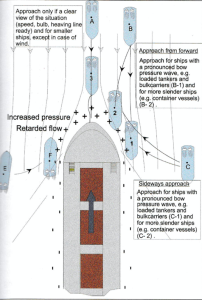The Charity
Aviation
Maritime
M1909

Initial Report
A tug had been engaged to assist a RO-RO passenger ferry in berthing in high winds. The ferry’s master held a pilotage exemption certificate for the port, so no pilot was embarked. The tug was manoeuvring close to the port bow of the ferry and attempting to connect a tow line when its stern collided with the ferry’s bulbous bow, where it became pinioned, heeled to port and took on water. This caused the tug to capsize, resulting in the loss of 2 crew.
The tug manoeuvred close to the RO-ROs bow to connect the tow. However, once it had left the ‘safe zone’, the hydrodynamic interaction between the vessels’ hulls drew the tug towards the ferry’s bulbous bow
Diagram courtesy of Captain Henk Hensen – Tug use in port: A practical guide.
The ferry’s speed through the water was too fast to connect a tow line safely. The high speed meant that the ‘safe zone’ was further away from the ferry’s hull, and the tug had to use most of its available engine power to match the ship’s speed, leaving minimal reserve power for the tug to manoeuvre.
The pilot-exempt master of the ferry was not required to have undergone additional training for tug assistance, which was usually requested during adverse and challenging weather conditions.
Water down-flooded through an open door and engine-room ventilation duct when the tug turned broadside on and heeled over. This allowed down-flooding to occur, further reducing stability and ultimately leading to capsizing.
The tug crew could not close the engine-room ventilation duct during operations because it was required to be open to supply air for the tug’s engines.
The tug did not comply with stability requirements, which meant it was prone to excessive heeling during operations and early down-flooding.
CHIRP Comment
Establishing a tow between a tug and ship should be conducted at as low a speed as practicable in the circumstances and conditions to give the tug greater manoeuvrability and avoid it departing from the “safe zone” where dynamic interaction is less likely to occur.
Ship masters (especially pilot-exempt masters) and tug masters must thoroughly understand the theoretical and practical aspects of safe tug/ship operations.
Tugs should be fit for the purpose for which they are being used, with sufficient power and manoeuvrability for the intended operation, and should always comply with stability requirements. Down-flooding will quickly erode any stability reserves and will be a significant factor contributing to a capsizing. During critical or high-risk operations, all doors and other openings that need not be opened should be securely closed.
It is considered necessary for tug masters to have a good understanding of the elements of tug stability. They need to know where the limits are and the consequences of tug handling practices not conforming to the rules of stability in normal circumstances.
A tug’s stability is not a static condition but can change rapidly due to the evolving forces acting on the tow line and the dynamic interaction between the tug and its tow. These changing forces can negatively affect the tug’s stability if they are not adequately monitored and controlled. In this case, as tragically shown in this report, it culminated in the capsizing of the tug with loss of life.
Key Issues relating to this report
Capability– Do you understand the risks to your tug when operating in the vicinity of a vessel requiring a tow line? What checks do you make before attempting to make the tow line fast? Would you ask the vessel to slow down before approaching? See Tug use in port: A practical guide. by Captain Henk Hensen.
Does your company provide the necessary theoretical and practical stability training for tug masters and mates?
Local Practices– Are the requirements for engaging with a tug by a PEC master the same at every port? Do the IMPA have any criteria for PEC masters and their training? Should the port require that a PEC master be examined in managing the use of a tug?
Pressure- Was there any pressure not to take on a pilot, because the master had an exemption certificate?
Alerting- As a master with a PEC for the port, would you consider asking for assistance from an experienced pilot to manage tug use?
This data type is not supported!






